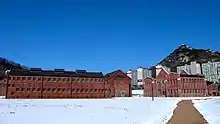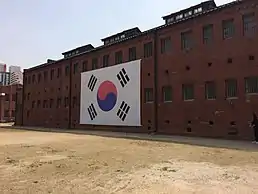Seodaemun Prison
Seodaemun Prison History Hall is a museum and former prison in Seodaemun-gu, Seoul, South Korea. It was constructed beginning in 1907. The prison was opened on October 21, 1908, under the name Gyeongseong Gamok. During the early part of the Japanese colonial period it was known as Keijo Prison[1] (Keijō Kangoku, the Japanese pronunciation of Gyeongseong Gamok). Its name was changed to Seodaemun Prison in 1923, and it later had several other names.[2]
| Seodaemun Prison | |
 The barracks of Seodaemun Prison | |
| Korean name | |
|---|---|
| Hangul | 서대문 형무소 |
| Hanja | 西大門刑務所 |
| Revised Romanization | Seodaemun Hyeongmuso |
| McCune–Reischauer | Sŏdaemun Hyŏngmuso |
| Original name | |
| Hangul | 경성감옥 |
| Hanja | 京城監獄 |
| Revised Romanization | Gyeongsong Gamok |
| McCune–Reischauer | Kyŏngsŏng Kamok |
| Later names | |
| Hangul | 서울형무소
서울교도소 서울구치소 |
| Hanja | 서울刑務所
서울矯導所 서울拘置所 |
| Revised Romanization |
|
| McCune–Reischauer |
|
Literal translations:
| |

History
The prison was used during the Japanese colonial period to imprison Korean liberation activists, and could originally hold around 500 inmates.[3] It had a separate facility for women and young girls. In 1911, Kim Koo was imprisoned. He was one of the more important figures in the Korean liberation movement. In 1919, shortly after the March 1st Movement, the number of imprisoned increased drastically.[4] About three thousand liberation activists were imprisoned,[3] and shortly before the colonization ended in 1945, the number of prisoners was at 2980. Among imprisoned after the March 1st Movement was Ryu Gwansun, who died from the torture inflicted on her.[5]
After the colonial era ended in 1945 as part of the surrender of Japan in World War II, the prison was used by the South Korean government, and was known by various official names, including Seoul Prison until 1961, Seoul Correctional Institute until 1967 and Seoul Detention Center until its closure in 1987. It was replaced by a facility in Uiwang City, Gyeonggi Province.[6]
In 1992, the site was dedicated as the Seodaemun Prison History Hall, part of Seodaemun Independence Park. Seven of the prison complex's original fifteen buildings are preserved as historical monuments. The History Hall showcases all those imprisoned during the Japanese colonial period and continues to serve as a memorial hall.[7]
Location
.jpg.webp)
Seodaemun Independence Park, including Seodaemun Prison, is easily accessed from exits 4 or 5 of the Dongnimmun Station on Seoul Subway Line 3.
References
- Annual Report on Reforms and Progress in Chosen. Government-General of Korea. 1923.
- Lee, Hyun Kyung (23 April 2019). 'Difficult Heritage' in Nation Building: South Korea. ISBN 9783319663388.
- Joel Lee (2 August 2018). "Former prison lives with vestiges of Korea's patriotic past". The Korea Herald. Retrieved 21 May 2019.
- Chang, Dae-oup (13 January 2009). Capitalist Development in Korea. ISBN 9781134046454.
- For reconciliation: Textbook, Comfort women, Yasukuni shrine and Liancourt Rocks (in Japanese). Heibonsha. 2006. p. 53. ISBN 9784582702651.
- "인왕산 도성탐방기<2>서대문형무소역사관, 국사당, 선바위". The Hankyoreh. 9 May 2017. Retrieved 13 May 2018.
- "Korea". 2013.
